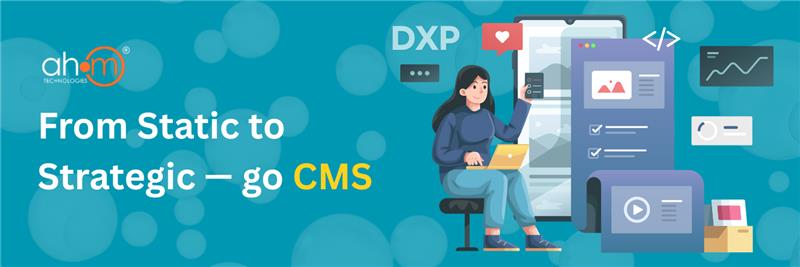Introduction
For years, managing a website was the main goal of digital teams — creating pages, updating content, and keeping things running smoothly. But digital engagement isn’t limited to websites anymore. Today’s audiences interact with brands across apps, emails, chatbots, and social platforms.
To keep up with this shift, businesses need tools that do more than just manage web pages — they need systems that can connect every experience. That’s where Digital Experience Platforms (DXPs) step in.
For a long time, content management systems (CMS) have been the backbone of how organizations create and publish their digital content.They made website management easier and gave marketers more control. But as the digital landscape expanded — websites, apps, voice assistants, and social media — traditional CMS platforms started showing their limits.
Businesses needed a way to connect all these touchpoints and manage them from one place. That’s how Digital Experience Platforms (DXPs) came into the picture.
Why Traditional CMS Platforms Fall Short
A CMS works well for a single website. But when businesses want to manage content across multiple platforms or provide personalized experiences, the cracks begin to show.
Some of the most common limitations include:
- Lack of flexibility: Difficult to integrate new tools or channels.
- Siloed systems: Each platform stores its own data, making content reuse harder.
- Limited analytics: Hard to measure how content performs across multiple touchpoints.
- No personalization: Every visitor gets the same experience.
This is where DXPs bring a major shift — they help companies manage not just content, but complete digital experiences.
What Is a Digital Experience Platform (DXP)?
A Digital Experience Platform is an advanced system that brings together various digital tools — content management, analytics, personalization, and customer data — under one structure.
In simple terms, it’s a next-generation CMS that lets teams create, manage, and deliver consistent content across different devices and channels.
Key features of a DXP include:
- Headless architecture: Deliver the same content to multiple platforms — website, app, or any connected device.
- Integration with other tools: Connects easily with CRM, marketing, or eCommerce systems.
- Personalization: Displays content based on user behavior or preferences.
- Centralized analytics: Provides a single view of how content performs across all touchpoints.
How DXPs Improve Content Workflows
Shifting to a DXP doesn’t just change the technology — it transforms how teams work together.
Here’s how:
- Marketing teams can update and personalize content without depending on developers.
- Developers can focus on building features and integrations instead of handling repetitive content updates.
- Decision-makers get clearer insights into what content drives engagement.
In short, a DXP brings structure and speed to the entire content workflow.
At AHOM Technologies, our team helps organizations transition from traditional CMS systems to modern, headless, and composable architectures. This ensures faster content delivery and smoother collaboration between marketing and development teams.
The Role of Headless CMS in DXPs
A headless CMS is often the foundation of a DXP. It separates the backend (where content is stored) from the frontend (where content is displayed).
This makes it easier to publish content on websites, mobile apps, and even digital kiosks — all from one dashboard.
This flexibility is essential for businesses that want to stay consistent across channels.
AHOM’s CMS Development Services help companies choose and implement the right headless CMS solutions, ensuring scalability and performance.
Benefits of Adopting a DXP
- Unified Content Management: Create and manage content from a single place for all platforms.
- Improved Team Efficiency: Marketers and developers can work independently but stay connected through the same system.
- Data-Driven Decisions: Analytics and insights help in refining content strategies.
- Easy Integrations: DXPs connect smoothly with marketing tools, eCommerce platforms, and CRMs.
- Future Scalability: As technology evolves, new features and channels can be added easily.
Choosing the Right Time to Upgrade
If your business faces issues like duplicate content, slow publishing, or disconnected digital channels, it might be time to explore a DXP.
A good first step is a CMS audit — identifying what works, what doesn’t, and what needs improvement.
AHOM’s CMS Consulting and Integration Services can help assess your existing setup and guide you toward a system that aligns with your business goals.
Rethinking Content Management for the Next Decade
The shift from CMS to DXP isn’t just a technical upgrade — it’s a mindset change. Businesses are moving from managing pages to managing experiences.
DXPs allow organizations to deliver content that feels connected, timely, and relevant — no matter where the user interacts with it.
At AHOM Technologies, we support this transformation by helping brands modernize their digital platforms and build flexible, scalable ecosystems for the future.
Explore our CMS Development Services or connect with our Web Development Experts to modernize your digital experience today.


